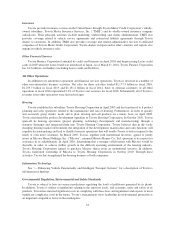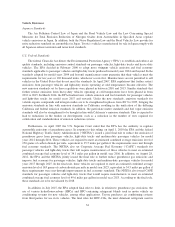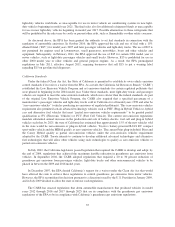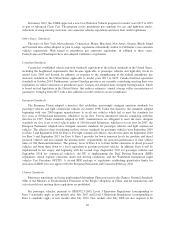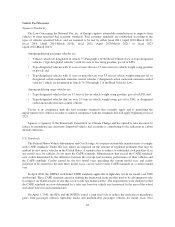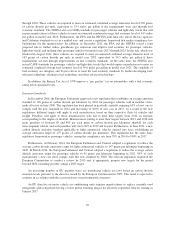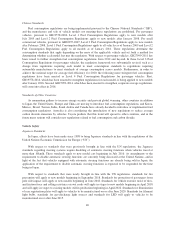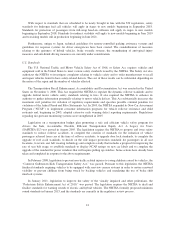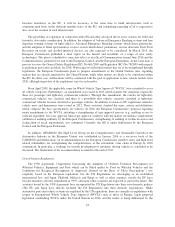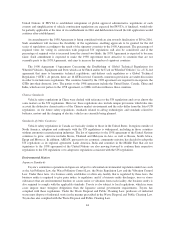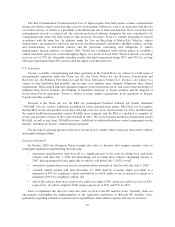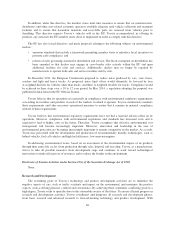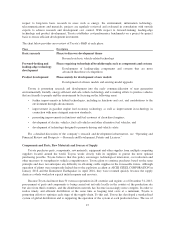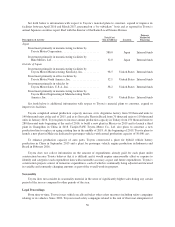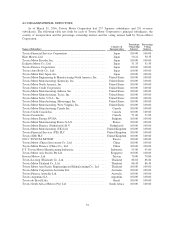Toyota 2015 Annual Report Download - page 47
Download and view the complete annual report
Please find page 47 of the 2015 Toyota annual report below. You can navigate through the pages in the report by either clicking on the pages listed below, or by using the keyword search tool below to find specific information within the annual report.In response to the unintended acceleration issue in 2010, the NHTSA has started to examine and implement
measures to strengthen safety standards, such as mandating brake override systems, mandating Event Data
Recorders, or EDR, and standardizing push-start switches.
In August 2014, the NHTSA initiated rulemaking that would propose to create a new safety standard to
require new passenger and light-duty truck vehicles to have dedicated short-range communication (DSRC) units
that enable Vehicle-to-Vehicle (V2V) communication.
In January 2015, the NHTSA proposed to amend safety standards regarding child restraint anchorage
systems to improve the ease of use, and in March 2015, the NHTSA proposed to amend a safety standard
regarding seat belt assembly anchorages to specify an alternative test procedure.
In March 2016, the NHTSA proposed changes to safety standards to add an alternative requirement for
electrical shock protection from electric vehicles and hydrogen fuel cell vehicles. In the same month, the NHTSA
and Insurance Institute for Highway Safety announced that they have agreed with twenty major vehicle
manufacturers to standardize equipment of automatic emergency brakes on almost all new models by 2022.
European Standards
In 2009, the European Union overhauled its safety regulations and enacted a new regulation and a simplified
framework, repealing more than 50 existing European Commission directives regarding vehicle safety other than
pedestrian protection, and replacing them with a single regulation aimed at incorporating the UN regulations. The
new regulation also requires the adoption of advanced safety systems. The EU Regulation directly incorporating
the UN Regulations commenced in 2012 and requires advanced safety systems, including requiring new type
vehicles to have electronic stability control systems from 2011, to introduce regulations relating to low rolling
resistance tires in 2013, to require tire pressure monitoring systems starting in 2012 and to require heavy vehicles
to have advanced emergency braking systems and lane departure warning systems from 2013. All of the technical
requirements for these advanced safety systems were discussed in the United Nations. Further, application of UN
regulation came into force from November 2012 for new vehicle types and from 2014 for all new vehicles sold in
the EU market. The new mandatory measures include electric car safety requirements and gear shift indicators.
In October 2010, CARS 21 was resumed in order to proceed with the realization of the “2020 Strategy”
(CARS 2020) by the European Commission that aims for high-level, sustainable and comprehensive growth, and
the CARS 21 final report was issued in June 2012. The final report addresses issues facing the widespread
adoption of electric vehicles, including charging infrastructure in the EU, establishing battery requirements,
adopting seat belt reminder devices for all seats, connection of alcohol interlock devices to vehicles, adopting
speed management devices, establishing safety requirements for micro urban mobility, strengthening safety
regulation to protect the vulnerable from collisions and the possibility of regulation in connection with
preventative safety technology. In November 2012, “CARS 2020: Action Plan for a competitive and sustainable
automotive industry in Europe” was issued based on the final report. The action plan is built on four core
concepts, and within these concepts it discusses enhancement of road safety, improving the market conditions
within the EU and the implementation of smart regulations. Each item is given a target date and is to be
monitored going forward. A stakeholder hearing on the implementation of the CARS 2020 action plan took place
in February 2014 in Brussels in preparation for the Commission’s final report, which the Commission published
in October 2014. The report indicates the direction for future short and medium term actions.
On the widespread adoption of emergency call systems (“eCall”), the European Commission concluded that
a legislative approach is effective as a result of the impact assessment by the Commission in 2011. Accordingly,
eCall will become mandatory from the end of March 2018 for light-duty passenger vehicles and light-duty
commercial vehicles using the framework of “Whole Vehicle Type Approval.” Regulations setting forth the
technical standards of eCall were adopted in May 2015. Rulemaking regarding eCall has also been proposed by
the United Nations, and is also currently being considered. In addition, in the event the installation of eCall
42



